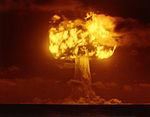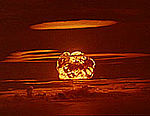- Operation Redwing
-
For the 2005 US counterterrorism mission in Kunar province, Afghanistan, see Operation Red Wings.
Operation Redwing 
Redwing ApacheInformation Country United States Test site Pacific Proving Grounds Period May-July 1956 Number of tests 17 Test type Atmospheric tests Device type Fission/Fusion Max. yield 5 megatons of TNT (21 PJ) Navigation Previous test Project 56 Next test Project 57 Operation Redwing was a United States series of 17 nuclear test detonations from May to July 1956. They were conducted at Bikini and Enewetak atolls. The entire operation followed Operation Wigwam and preceded Operation Plumbbob. The primary intention was to test new, second-generation thermonuclear devices. Also tested were fission devices intended to be used as primaries for thermonuclear weapons, and small tactical weapons for air defense. Redwing demonstrated the first US airdrop of a deliverable hydrogen bomb - test "Cherokee". Because the yields for many tests at Operation Castle in 1954 were dramatically higher than predictions, Redwing was conducted using an "energy budget" - there were limits to the total amount of energy released, and the amount of fission yield was also strictly controlled. Fission, primarily "fast" fission of the natural uranium tamper surrounding the fusion capsule, greatly increases the yield of thermonuclear devices, and contributes the vast majority of the fallout - fusion being a relatively clean reaction.
All shots were named after various US Native American tribes.
Michael Harris, a former public relations executive at CBS, served in the U.S. Army on Enewetak Atoll during most of Operation Redwing. He wrote about his experiences in The Atomic Times: My H-Bomb Year at the Pacific Proving Ground (Random House, 2005). To protect privacy, he changed most of the names of his fellow soldiers.
According to Harris in The Atomic Times, soldiers on Enewetak experienced fallout from eight blasts: 1) Zuni (3.5 megatons, Bikini) and Yuma (0.19 kilotons, Enewetak), both detonated on May 28, 1956; 2) Seminole, a 13.7 kiloton surface burst exploded inside a water tank on June 6, 1956; 3) Blackfoot (8 kilotons, Enewetak) and Flathead (365 kilotons, Bikini), another double shot day on June 12, 1956; 4) Inca (15.2 kilotons, Enewetak) on June 22, 1956; 5) Apache (1.85 megatons, Enewetak) on July 9, 1956; and 6) and Tewa (5 megatons, Bikini) on July 21, 1956, the “dirtiest shot ever,” according to Harris, with Enewetak being hit with “very heavy” fallout that lasted for days.
Harris personally experienced the Redwing Lacrosse through Redwing Dakota detonations, noting that the much smaller-yield explosions at Enewetak appeared to be the same size as the much larger explosions more than 150 miles away at Bikini. He left the atoll and was honorably discharged before the final five test shots, and therefore missed the most powerful detonations at Enewetak.
Tests
The following tests all took place in 1956. The dates are in local time, followed by the yield.
Redwing Tests[1] Test name Date Location Yield Note Image Lacrosse 4 May 1956 Enewetak Atoll 40 kilotons 11°33′14″N 162°20′53″E / 11.55389°N 162.34806°E 
Cherokee 20 May 1956 Bikini Atoll 3.8 megatons first US airdrop of a thermonuclear bomb, a Mark 15 nuclear bomb 
Zuni 27 May 1956 Bikini Atoll 3.5 megatons First test of a three-stage thermonuclear design (Bassoon device). 
Yuma 27 May 1956 Enewetak Atoll 190 tons a fizzle, but the device weighed only 96 pounds Erie 30 May 1956 Enewetak Atoll 14.9 kilotons Test of a prototype Mark 28 nuclear bomb 
Seminole June 6, 1956 Enewetak Atoll 13.7 kilotons Exploded in a tank of water to simulate an underwater explosion 
Flathead June 11, 1956 Bikini Atoll 365 kilotons intended to be particularly "dirty" - a high-fallout weapon 
Blackfoot June 11, 1956 Enewetak Atoll 8 kilotons 
Kickapoo June 13, 1956 Enewetak Atoll 1.49 kilotons Osage June 16, 1956 Enewetak Atoll 1.7 kilotons 
Inca June 21, 1956 Enewetak Atoll 15.2 kilotons Test of the swan primary. Dakota June 25, 1956 Bikini Atoll 1.1 megatons 
Mohawk July 2, 1956 Enewetak Atoll 360 kilotons Test of the swan primary and flute secondary. 
Apache July 8, 1956 Bikini Atoll 1.85 megatons 
Navajo July 10, 1956 Bikini Atoll 4.5 megatons 95% fusion, the cleanest US shot until the 1958 Hardtack Poplar shot, a 9.3 Mt shot of which 95.2% of the yield was from fusion.[2][3] 
Tewa July 20, 1956 Bikini Atoll 5 megatons Test of a dirty three stage thermonuclear design (Bassoon Prime device). 87% of the yield came from fission, the highest percentage in any known US thermonuclear test. 
Huron July 21, 1956 Enewetak Atoll 250 kilotons 
References
- ^ Redwing test series from The Nuclear Weapons Archive retrieved 31 May 2008
- ^ http://nuclearweaponarchive.org/Usa/Tests/Hardtack1.html
- ^ http://en.academic.ru/dic.nsf/enwiki/453500
- Chuck Hansen, U. S. Nuclear Weapons: The Secret History (Arlington: AeroFax, 1988)
- United States Nuclear Tests - DOE/NV—209-REV 15
- United States Nuclear Tests at fas.org
External links
- Defense Dept film summarizing Operation Redwing
- Defense Department film giving technical results of Redwing blasts
- Summary and review of The Atomic Times
Categories:- American nuclear explosive tests
- 1956
- Enewetak Atoll
- United States military stubs
Wikimedia Foundation. 2010.
